Building Integrated Photovoltaics 4.0: Digitization of the Photovoltaic Integration in Buildings for a Resilient Infra at Large Scale
Abstract
:1. Introduction
- A brief overview of the BIPV system along with different types of integration of PV modules with building envelopes represented pictorially.
- A discussion of various issues related to the performance of the BIPV system. The issues include the rise in PV modules’ temperature, different types of faults in PV modules, accumulation of dust particles over the modules, etc.
- A discussion of the significance and application of the digital technologies implementation for overcoming the different issues related to the BIPV system with the proposed architecture.
- Vital recommendations including ML and DL for image enhancement for flaws detection in real-time image data; edge computing to implement DL for intelligent BIPV data analytics; fog computing for 6G assisted IoT network in BIPV; edge computing integration in UAV for intelligent automation and detection; augmented reality, virtual reality, and digital twins for virtual BIPV system as a part of future directions. Research challenges are also discussed.
2. Overview of BIPV System
- (a)
- BIPV roof
- (b)
- BIPV facade
- (c)
- STPV glazing/windows
Issues/Challenges in the BIPV Systems
- The system attains a high temperature during the sunshine hours, which reduces power generation. It also affects the building envelope temperature and the building thermal comfort. For preventing the heating of the modules, an uncontrolled high-power forced ventilation is used, which consumes much energy leading to an overall reduction in system efficiency.
- In a large BIPV system, different types of optical, electrical, and non-classified faults occur, depending on the ambient condition, type of integration, and adjacent shadings on buildings that need to be analyzed regularly.
- Regular and safe cleaning of dust-accumulated PV modules in large buildings, roofs, facades, and fenestration is challenging, which reduces the overall efficiency of the BIPV system and daylight availability in buildings.
3. Digitalization for BIPV
- (a)
- IoT: IoT was first proposed at the end of the twentieth century, and it was developed using radiofrequency technology [20,21]. The GSMA estimates that the number of IoT connections will reach 25 billion worldwide by 2025 [22,23]. IoT is a collection of devices with embedded systems connected to the internet’s telecommunications network with the ability to generate and send data without the need for human interaction. IoT consists of machine-to-machine (M2M) networks, in which intelligent devices communicate with one another and make independent decisions based on created and transmitted data [24,25].
| Wireless Communication | Transmission Area | Bandwidth | Transmission Rate | Network Topology | Authentication |
|---|---|---|---|---|---|
| Sigfox | 9.5 km | 868 MHz (Europe); 915 MHz (US) | 100 bps | Star | Private key signature Encryption |
| NB-IoT | 15 km | LTE bands | 250 kbps | NA | 3GPP S3 security |
| LoRa | 7.2 km | 433 MHz (Asia), 868 MHz (Eu) and 915 MHz (US) | 0.25–5.5 kpbs | Star of stars | Distinctive key distribution, |
| BLE | 150 m | 2.4 GHz | 1 Mbps | Star, bus | Secure pairing before the key exchange |
| Zigbee | 30 m | 2.4 GHz | 250 kbps | Star, Peer 2Peer (P2P), mesh, tree, | AES-128b, Network key |
| Wi-Fi | 100 m | 2.4 GHz | 54 Mb/s | Point-to-hub | |
| MQTT | Machine 2 Machine (M2M) | 2.4 GHz | 2 Mbps | TLS/SSL |
- (b)
- AI: AI is the process of creating intelligent devices out of massive amounts of data [31]. Human-like tasks are performed by systems that learn from previous learning and experiences. Human efforts are improved in terms of speed, precision, and efficacy. To create machines that can make judgments on their own, AI uses complicated algorithms and methodologies. Figure 6 illustrates the subsets of AI, and they are machine learning (ML), deep learning (DL), expert systems, natural language processing (NLP), robotics, vision, and speech recognition [32]. ML is a branch of AI that offers intelligence to computers by allowing them to learn from their experiences without being explicitly programmed [33].
- (c)
- Edge computing: In IoT, many computing paradigms such as edge computing, cloud computing, and mobile ad hoc cloud (MAC) are employed to provide various services based on the application requirements [35]. Real-time delay-sensitive applications cannot accept prolonged delays generated by a wide area network during IoT installation. IoT devices have limited processing power, making them inadequate for computationally intensive workloads [36]. Edge computing is a decentralized computing platform that offers cloud computing capabilities to IoT devices at the network edge. However, IoT devices with limited resources can enhance their capabilities by utilizing the resources of edge servers. Latency minimization, network management, cost optimization, energy management, resource management, and data management are the advantages of edge computing implementation [37].
- (d)
- UAV: The technology can be customized and used for fast mobile applications that can be employed in a variety of smart city applications. UAV technology is developed to match smart city criteria and functions that will productively connect UAVs to smart cities [38]. By enabling a UAV with monitoring sensors, cameras, as well as software, we can perform smart city infrastructure inspection and control applications [39]. Furthermore, one of the emerging fields of UAVs is their involvement in smart city applications, which results in a variety of benefits. UAVs, as compared to manned planes, can be more cost-effective. They are more adaptable and can function in a variety of environments and settings, including those that are difficult or dangerous to people. Traffic monitoring and management, health emergency services, security and crowd monitoring, UAV-based infrastructure inspections, agriculture management, environmental monitoring, tourism support, and UAV-aided wireless communications are the applications of UAVs [40].
- Sensing: Sensing technology enables the establishment of an ecosystem for connecting the physical and virtual worlds. Sensors collect signals, convert them to digital data, and process them. Further, the information on the present status of the physical environment is converted into usable data.
- IoT: IoT is built on the integration of many standards and supporting technologies such as sensors, communication protocol, storage, computational, and other capabilities. At present, the advancement in sensor technology and communication protocol empowers us to implement IoT in various applications for real-time analysis. The application of IoT in the BIPV system enables us to monitor and control the BIPV system from any remote location in real-time.
- AI: The implementation of IoT generates a large amount of sensor and visual data. The evolution of AI simulates human intelligent behavior with computers and trains computers to learn human characteristics such as judgment, learning, and decision-making. The application of AI with IoT enables us to predict events based on real-time data.
- Data Analytics: Advanced data analytics reveals computing approaches, allowing for the interpretation of data. It is critical for converting huge data into usable data for better decision-making.
- Edge Computing: Data is currently being increasingly generated at the edge of the network, and it would be more effective to handle the data there as well. Edge computing refers to the technologies that enable computation to be conducted at the network’s edge, on downstream data for cloud services and upstream data for IoT services.
- Drone Technology: A drone is a type of unmanned aircraft. A drone is effectively a flying robot that can be operated remotely or autonomously by software-controlled flight patterns in its embedded systems, which work in concert with onboard sensors and GPS.
- Robotics Technology: An autonomous robot is a system that operates in an unpredictable and partially unknown environment, and it is able to navigate without interruption and avoid any obstacles placed within the mobility confinement. The integration of IoT with robotics enables the realization of the robotics-based automated system for different applications in the BIPV system.
- Human to BIPV interaction: The digitalization of the BIPV system is relevant to controlling the performance of the system and rectifying the issues. Interaction of humans with the BIPV system is important to manage its performance.
4. Measures to Overcome the Challenges
4.1. High Temperature of BIPV System
4.2. Faults Occurrence in the BIPV System
4.3. Dust Accumulation on BIPV
5. Future Directions and Research Challenges
Next Generation Computing for Digitalization of the Photovoltaic Integration
- (a)
- Future directions
- ML and DL for image enhancement for flaws detection in real-time image data
- Edge computing to implement DL for Intelligent BIPV data analytics
- Fog computing for 6G assisted IoT network in BIPV
- Edge computing integration in UAV for intelligent automation and detection
- Augmented Reality, Virtual Reality, and Digital Twins for virtual BIPV system
- (b)
- Research challenges
- The implementation of AI in edge computing has significant advantages, along with a few challenges that require the focus of researchers, such as computational power, memory, security, and power management of the edge devices. In the area of BIPV, the energy generated by the edge devices will be based on renewable energy, however, the life of edge devices concerning the performance of computational activities is challenging because the replacement of edge devices within a short period also increases the infrastructure and adds another operating cost.
- Along with the life of the edge devices, another significant parameter that needs to be considered is the security and privacy of the data. In the context of the BIPV, the building structure data, and the panel details with location are shared on the edge network. The data is comprised during transmission from the edge to the cloud server. Recently, blockchain has been integrated with edge computing to achieve secure authentication and collaboration with trusted distributers [77,78].
- To perform the high computational activities with AI, there is a need for additional computational hardware and this hardware consumes a lot of energy to perform the computational activities [79]. The reduction of computation immediately reduces energy consumption, where there is a need for a deeper understanding of AI computation with battery management measures, such as CPU throttling and sensor hardware modifications, which is an attractive research avenue [80]. Changes in input data, whether detected in software or hardware, can help reduce the frequency of AI runs and overall energy consumption. This challenge enables us to carry out research for better understanding of hardware chips (GPUs and TPUs) during the computation process.
6. Conclusions
Author Contributions
Funding
Conflicts of Interest
References
- SDG 9: Industry, Innovation and Infrastructure. Available online: https://in.one.un.org/page/sustainable-development-goals/sdg-9/ (accessed on 3 June 2022).
- SDG 7: Affordable and Clean Energy. Available online: https://in.one.un.org/page/sustainable-development-goals/sdg-7/ (accessed on 3 June 2022).
- #Envision2030 Goal 11: Sustainable Cities and Communities | United Nations Enable. Available online: https://www.un.org/development/desa/disabilities/envision2030-goal11.html (accessed on 11 June 2022).
- Renewables—Global Energy Review 2020—Analysis—IEA. Available online: https://www.iea.org/reports/global-energy-review-2020/renewables (accessed on 13 August 2022).
- Singh, D.; Chaudhary, R.; Karthick, A. Review on the progress of building-applied/integrated photovoltaic system. Environ. Sci. Pollut. Res. 2021, 28, 47689–47724. [Google Scholar] [CrossRef] [PubMed]
- Sahu, A.; Yadav, N.; Sudhakar, K. Floating photovoltaic power plant: A review. Renew. Sustain. Energy Rev. 2016, 66, 815–824. [Google Scholar] [CrossRef]
- Singh, D.; Gautam, A.K.; Chaudhary, R. Potential and performance estimation of free-standing and building integrated photovoltaic technologies for different climatic zones of India. Energy Built Environ. 2020, 3, 40–55. [Google Scholar] [CrossRef]
- Tsanakas, J.A.; Ha, L.; Buerhop, C. Faults and infrared thermographic diagnosis in operating c-Si photovoltaic modules: A review of research and future challenges. Renew. Sustain. Energy Rev. 2016, 62, 695–709. [Google Scholar] [CrossRef]
- Paliwoda, B.; Krzysztof, W.; Biega, M. Internet of Things in Industry: Research Profiling, Application, Challenges and Opportunities—A Review. Energies 2022, 15(5), 1806. [Google Scholar] [CrossRef]
- Singh, D.; Chaudhary, R. Impact of roof attached Photovoltaic modules on building material performance. Mater. Today Proc. 2021, 46, 445–450. [Google Scholar] [CrossRef]
- Singh, D.; Rawat, M.; Singh, S.P.; Chaudhary, R. Performance of PV integrated wall and roof as a building material. In Proceedings of the IOP Conference Series: Materials Science and Engineering, Punjab, India, 28–30 August 2020; IOP Publishing: Bristol, UK; Volume 1033, p. 12005. [Google Scholar]
- Ma, T.; Yang, H.; Zhang, Y.; Lu, L.; Wang, X. Using phase change materials in photovoltaic systems for thermal regulation and electrical efficiency improvement: A review and outlook. Renew. Sustain. Energy Rev. 2015, 43, 1273–1284. [Google Scholar] [CrossRef]
- Siddiqui, M.U.; Arif, A.F.M.; Kelley, L.; Dubowsky, S. Three-dimensional thermal modeling of a photovoltaic module under varying conditions. Sol. Energy 2012, 86, 2620–2631. [Google Scholar] [CrossRef]
- Poulek, V.; Matuška, T.; Libra, M.; Kachalouski, E.; Sedláček, J. Influence of increased temperature on energy production of roof integrated PV panels. Energy Build. 2018, 166, 418–425. [Google Scholar] [CrossRef]
- Radziemska, E.; Klugmann, E. Thermally affected parameters of the current–voltage characteristics of silicon photocell. Energy Convers. Manag. 2002, 43, 1889–1900. [Google Scholar] [CrossRef]
- Vats, K.; Tiwari, G.N. Performance evaluation of a building integrated semitransparent photovoltaic thermal system for roof and façade. Energy Build. 2012, 45, 211–218. [Google Scholar] [CrossRef]
- Agathokleous, R.; Kalogirou, S. Simulation-Based Investigation of the Air Velocity in a Naturally Ventilated BIPV System. In Proceedings of the Conference on Sustainable Energy, Brasov, Romania, 19–21 October 2017; Springer: Cham, Switzerland, 2017; pp. 201–217. [Google Scholar]
- Park, K.E.; Kang, G.H.; Kim, H.I.; Yu, G.J.; Kim, J.T. Analysis of thermal and electrical performance of semi-transparent photovoltaic (PV) module. Energy 2010, 35, 2681–2687. [Google Scholar] [CrossRef]
- Vats, K.; Tomar, V.; Tiwari, G.N. Effect of packing factor on the performance of a building integrated semitransparent photovoltaic thermal (BISPVT) system with air duct. Energy Build. 2012, 53, 159–165. [Google Scholar] [CrossRef]
- Al-Fuqaha, A.; Guizani, M.; Mohammadi, M.; Aledhari, M.; Ayyash, M. Internet of Things: A Survey on Enabling Technologies, Protocols, and Applications. IEEE Commun. Surv. Tutor. 2015, 17, 2347–2376. [Google Scholar] [CrossRef]
- Kimothi, S.; Thapliyal, A.; Akram, S.V.; Singh, R.; Gehlot, A.; Mohamed, H.G.; Anand, D.; Ibrahim, M.; Noya, I.D. Big Data Analysis Framework for Water Quality Indicators with Assimilation of IoT and ML. Electronics 2022, 11, 1927. [Google Scholar] [CrossRef]
- Kimothi, S.; Singh, R.; Gehlot, A.; Akram, S.V.; Malik, P.K.; Gupta, A.; Bilandi, N. Intelligent energy and ecosystem for real-time monitoring of glaciers. Comput. Electr. Eng. 2022, 102, 108163. [Google Scholar] [CrossRef]
- GSMA | IoT Connections Forecast: The Rise of Enterprise | Internet of Things. Available online: https://www.gsma.com/iot/resources/iot-connections-forecast-the-rise-of-enterprise/ (accessed on 6 February 2021).
- Boyes, H.; Hallaq, B.; Cunningham, J.; Watson, T. The industrial internet of things (IIoT): An analysis framework. Comput. Ind. 2018, 101, 1–12. [Google Scholar] [CrossRef]
- Fatorachian, H.; Kazemi, H. Impact of Industry 4.0 on supply chain performance. Prod. Plan. Control 2021, 32, 63–81. [Google Scholar] [CrossRef]
- Ud Din, I.; Guizani, M.; Hassan, S.; Kim, B.S.; Khurram Khan, M.; Atiquzzaman, M.; Ahmed, S.H. The Internet of Things: A Review of Enabled Technologies and Future Challenges. IEEE Access 2019, 7, 7606–7640. [Google Scholar] [CrossRef]
- Ray, P.P. A survey of IoT cloud platforms. Futur. Comput. Inform. J. 2016, 1, 35–46. [Google Scholar] [CrossRef]
- Nižetić, S.; Šolić, P.; González-de, D.L.-I.; Patrono, L. Internet of Things (IoT): Opportunities, issues and challenges towards a smart and sustainable future. J. Clean. Prod. 2020, 274, 122877. [Google Scholar] [CrossRef] [PubMed]
- Mekki, K.; Bajic, E.; Chaxel, F.; Meyer, F. A comparative study of LPWAN technologies for large-scale IoT deployment. ICT Express 2019, 5, 1–7. [Google Scholar] [CrossRef]
- Singh, R.; Sharma, R.; Akram, S.V.; Gehlot, A.; Buddhi, D.; Malik, P.K.; Arya, R. Highway 4.0: Digitalization of highways for vulnerable road safety development with intelligent IoT sensors and machine learning. Saf. Sci. 2021, 143, 105407. [Google Scholar] [CrossRef]
- Shi, F.; Ning, H.; Huangfu, W.; Zhang, F.; Wei, D.; Hong, T.; Daneshmand, M. Recent Progress on the Convergence of the Internet of Things and Artificial Intelligence. IEEE Netw. 2020, 34, 8–15. [Google Scholar] [CrossRef]
- Zhang, C.; Lu, Y. Study on artificial intelligence: The state of the art and future prospects. J. Ind. Inf. Integr. 2021, 23, 100224. [Google Scholar] [CrossRef]
- Borges, A.F.S.; Laurindo, F.J.B.; Spínola, M.M.; Gonçalves, R.F.; Mattos, C.A. The strategic use of artificial intelligence in the digital era: Systematic literature review and future research directions. Int. J. Inf. Manag. 2021, 57, 102225. [Google Scholar] [CrossRef]
- Collins, C.; Dennehy, D.; Conboy, K.; Mikalef, P. Artificial intelligence in information systems research: A systematic literature review and research agenda. Int. J. Inf. Manag. 2021, 60, 102383. [Google Scholar] [CrossRef]
- Hassan, N.; Gillani, S.; Ahmed, E.; Yaqoob, I.; Imran, M. The Role of Edge Computing in Internet of Things. IEEE Commun. Mag. 2018, 56, 110–115. [Google Scholar] [CrossRef]
- Shi, W.; Cao, J.; Zhang, Q.; Li, Y.; Xu, L. Edge Computing: Vision and Challenges. IEEE Internet Things J. 2016, 3, 637–646. [Google Scholar] [CrossRef]
- Yu, W.; Liang, F.; He, X.; Hatcher, W.G.; Lu, C.; Lin, J.; Yang, X. A Survey on the Edge Computing for the Internet of Things. IEEE Access 2017, 6, 6900–6919. [Google Scholar] [CrossRef]
- Mohamed, N.; Al-Jaroodi, J.; Jawhar, I.; Idries, A.; Mohammed, F. Unmanned aerial vehicles applications in future smart cities. Technol. Forecast. Soc. Change 2020, 153, 119293. [Google Scholar] [CrossRef]
- Alsamhi, S.H.; Ma, O.; Ansari, M.S.; Almalki, F.A. Survey on collaborative smart drones and internet of things for improving smartness of smart cities. IEEE Access 2019, 7, 128125–128152. [Google Scholar] [CrossRef]
- Abualigah, L.; Diabat, A.; Sumari, P.; Gandomi, A.H. Applications, deployments, and integration of internet of drones (iod): A review. IEEE Sens. J. 2021, 21, 25532–25546. [Google Scholar] [CrossRef]
- de Arquer Fernández, P.; Fernández, M.Á.F.; Candás, J.L.C.; Arboleya, P.A. An IoT open source platform for photovoltaic plants supervision. Int. J. Electr. Power Energy Syst. 2021, 125, 106540. [Google Scholar] [CrossRef]
- Adhya, S.; Saha, D.; Das, A.; Jana, J.; Saha, H. An IoT based smart solar photovoltaic remote monitoring and control unit. In Proceedings of the 2016 2nd International Conference on Control, Instrumentation, Energy & Communication (CIEC), Kolkata, India, 28–30 January 2016; pp. 432–436. [Google Scholar]
- Cheddadi, Y.; Cheddadi, H.; Cheddadi, F.; Errahimi, F.; Es-sbai, N. Design and implementation of an intelligent low-cost IoT solution for energy monitoring of photovoltaic stations. SN Appl. Sci. 2020, 2, 1–11. [Google Scholar] [CrossRef]
- Sarkar, S.; Rao, K.U.; Bhargav, J.; Sheshaprasad, S.; Anirudh Sharma, C.A. IoT Based Wireless Sensor Network (WSN) for Condition Monitoring of Low Power Rooftop PV Panels. In Proceedings of the 2019 IEEE 4th International Conference on Condition Assessment Techniques in Electrical Systems (CATCON), Chennai, India, 21–23 November 2019; pp. 1–5. [Google Scholar]
- Márquez, F.P.G.; Ramírez, I.S. Condition monitoring system for solar power plants with radiometric and thermographic sensors embedded in unmanned aerial vehicles. Measurement 2019, 139, 152–162. [Google Scholar] [CrossRef]
- Qasem, H.; Mnatsakanyan, A.; Banda, P. Assessing dust on PV modules using image processing techniques. In Proceedings of the 2016 IEEE 43rd Photovoltaic Specialists Conference (PVSC), Portland, OR, USA, 5–10 June 2016; pp. 2066–2070. [Google Scholar]
- Parrott, B.; Zanini, P.C.; Shehri, A.; Kotsovos, K.; Gereige, I. Automated, robotic dry-cleaning of solar panels in Thuwal, Saudi Arabia using a silicone rubber brush. Sol. Energy 2018, 171, 526–533. [Google Scholar] [CrossRef]
- Khadka, N.; Bista, A.; Adhikari, B.; Shrestha, A.; Bista, D. Smart solar photovoltaic panel cleaning system. In Proceedings of the IOP Conference Series: Earth and Environmental Science, Bangkok, Thailand, 11–14 December 2020; IOP Publishing: Philadelphia, PA, USA, 2020; Volume 463, p. 12121. [Google Scholar]
- Laudani, A.; Lozito, G.M.; Radicioni, M.; Fulginei, F.R.; Salvini, A. Optimal PV Panel Reconfiguration Using Wireless Irradiance Distributed Sensing. In ELECTRIMACS 2019; Springer: Cham, Switzerland, 2020; pp. 525–537. [Google Scholar]
- Niccolai, A.; Grimaccia, F.; Leva, S. Advanced asset management tools in photovoltaic plant monitoring: UAV-based digital mapping. Energies 2019, 12, 4736. [Google Scholar] [CrossRef]
- Athienitis, A.K.; Bambara, J.; O’Neill, B.; Faille, J. A prototype photovoltaic/thermal system integrated with transpired collector. Sol. Energy 2011, 85, 139–153. [Google Scholar] [CrossRef]
- Jie, J.; Hua, Y.; Gang, P.; Bin, J.; Wei, H. Study of PV-Trombe wall assisted with DC fan. Build. Environ. 2007, 42, 3529–3539. [Google Scholar] [CrossRef]
- Amelia, A.R.; Irwan, Y.M.; Irwanto, M.; Leow, W.Z.; Gomesh, N.; Safwati, I.; Anuar, M.A.M. Cooling on photovoltaic panel using forced air convection induced by DC fan. Int. J. Electr. Comput. Eng. 2016, 6, 526. [Google Scholar]
- Koch, S.; Weber, T.; Sobottka, C.; Fladung, A.; Clemens, P.; Berghold, J. Outdoor electroluminescence imaging of crystalline photovoltaic modules: Comparative study between manual ground-level inspections and drone-based aerial surveys. In Proceedings of the 32nd European Photovoltaic Solar Energy Conference and Exhibition, Munich, Germany, 20–24 June 2016; pp. 1736–1740. [Google Scholar]
- Thermal Imaging Camera in Solar Industry. Available online: https://www.ulirvisiontech.com/application/solar-industry.html (accessed on 11 June 2022).
- Tsanakas, J.A.; Vannier, G.; Plissonnier, A.; Ha, D.L.; Barruel, F. Fault diagnosis and classification of large-scale photovoltaic plants through aerial orthophoto thermal mapping. In Proceedings of the 31st European Photovoltaic Solar Energy Conference and Exhibition, Hamburg, Germany, 14–18 September 2015; pp. 1783–1788. [Google Scholar]
- Solar Drone Inspection Provider Raptor Maps Secures $22 Million in Funding—Pv Magazine International. Available online: https://www.pv-magazine.com/2022/04/15/solar-drone-inspection-provider-raptor-maps-secures-22-million-series-b/ (accessed on 11 June 2022).
- Kazem, H.A.; Chaichan, M.T.; Al-Waeli, A.H.A.; Sopian, K. A review of dust accumulation and cleaning methods for solar photovoltaic systems. J. Clean. Prod. 2020, 276, 123187. [Google Scholar] [CrossRef]
- Aïssa, B.; Isaifan, R.J.; Madhavan, V.E.; Abdallah, A.A. Structural and physical properties of the dust particles in Qatar and their influence on the PV panel performance. Sci. Rep. 2016, 6, 1–12. [Google Scholar]
- Hudedmani, M.G.; Joshi, G.; Umayal, R.M.; Revankar, A. A comparative study of dust cleaning methods for the solar PV panels. Adv. J. Grad. Res. 2017, 1, 24–29. [Google Scholar] [CrossRef]
- Gupta, V.; Sharma, M.; Pachauri, R.K.; Babu, K.N.D. A low-cost real-time IOT enabled data acquisition system for monitoring of PV system. Energy Sources Part A Recovery Util. Environ. Eff. 2021, 43, 2529–2543. [Google Scholar] [CrossRef]
- Kumar, N.M.; Sudhakar, K.; Samykano, M.; Sukumaran, S. Dust cleaning robots (DCR) for BIPV and BAPV solar power plants-A conceptual framework and research challenges. Procedia Comput. Sci. 2018, 133, 746–754. [Google Scholar] [CrossRef]
- Gill, S.S.; Xu, M.; Ottaviani, C.; Patros, P.; Bahsoon, R.; Shaghaghi, A.; Golec, M.; Stankovski, V.; Wu, H.; Abraham, A.; et al. AI for next generation computing: Emerging trends and future directions. Internet Things 2022, 19, 1–43. [Google Scholar] [CrossRef]
- Kim, B.; Serfa Juan, R.O.; Lee, D.E.; Chen, Z. Importance of Image Enhancement and CDF for Fault Assessment of Photovoltaic Module Using IR Thermal Image. Appl. Sci. 2021, 11, 8388. [Google Scholar] [CrossRef]
- Kurukuru, V.S.B.; Haque, A.; Khan, M.A.; Tripathy, A.K. Fault classification for Photovoltaic Modules Using Thermography and Machine Learning Techniques. In Proceedings of the 2019 International Conference on Computer and Information Sciences (ICCIS), Sakaka, Saudi Arabia, 3–4 April 2019. [Google Scholar] [CrossRef]
- Ali, M.U.; Khan, H.F.; Masud, M.; Kallu, K.D.; Zafar, A. A machine learning framework to identify the hotspot in photovoltaic module using infrared thermography. Sol. Energy 2020, 208, 643–651. [Google Scholar] [CrossRef]
- Chen, J.; Ran, X. Deep Learning with Edge Computing: A Review. Proc. IEEE 2019, 107, 1655–1674. [Google Scholar] [CrossRef]
- Nastic, S.; Rausch, T.; Scekic, O.; Dustdar, S.; Gusev, M.; Koteska, B.; Kostoska, M.; Jakimovski, B.; Ristov, S.; Prodan, R. A serverless real-time data analytics platform for edge computing. IEEE Internet Comput. 2017, 21, 64–71. [Google Scholar] [CrossRef]
- Chang, Z.; Liu, S.; Xiong, X.; Cai, Z.; Tu, G. A survey of recent advances in edge-computing-powered artificial intelligence of things. IEEE Internet Things J. 2021, 8, 13849–13875. [Google Scholar] [CrossRef]
- Malik, U.M.; Javed, M.A.; Zeadally, S.; ul Islam, S. Energy efficient fog computing for 6G enabled massive IoT: Recent trends and future opportunities. IEEE Internet Things J. 2021, 4662, 1–22. [Google Scholar] [CrossRef]
- Aazam, M.; Zeadally, S.; Harras, K.A. Deploying Fog Computing in Industrial Internet of Things and Industry 4.0. IEEE Trans. Ind. Inform. 2018, 14, 4674–4682. [Google Scholar] [CrossRef]
- Zhou, Y.; Pan, C.; Yeoh, P.L.; Wang, K.; Elkashlan, M.; Vucetic, B.; Li, Y. Secure communications for UAV-enabled mobile edge computing systems. IEEE Trans. Commun. 2019, 68, 376–388. [Google Scholar] [CrossRef]
- Yazid, Y.; Ez-Zazi, I.; Guerrero-González, A.; El Oualkadi, A.; Arioua, M. UAV-Enabled Mobile Edge-Computing for IoT Based on AI: A Comprehensive Review. Drones 2021, 5, 148. [Google Scholar] [CrossRef]
- Kumari, A.; Gupta, R.; Tanwar, S.; Kumar, N. A taxonomy of blockchain-enabled softwarization for secure UAV network. Comput. Commun. 2020, 161, 304–323. [Google Scholar] [CrossRef]
- Singh, M.; Fuenmayor, E.; Hinchy, E.P.; Qiao, Y.; Murray, N.; Devine, D. Digital twin: Origin to future. Appl. Syst. Innov. 2021, 4, 36. [Google Scholar] [CrossRef]
- Barricelli, B.R.; Casiraghi, E.; Fogli, D. A survey on digital twin: Definitions, characteristics, applications, and design implications. IEEE Access 2019, 7, 167653–167671. [Google Scholar] [CrossRef]
- Yang, R.; Yu, F.R.; Si, P.; Yang, Z.; Zhang, Y. Integrated Blockchain and Edge Computing Systems: A Survey, Some Research Issues and Challenges. IEEE Commun. Surv. Tutor. 2019, 21, 1508–1532. [Google Scholar] [CrossRef]
- Guo, S.; Hu, X.; Guo, S.; Qiu, X.; Qi, F. Blockchain Meets Edge Computing: A Distributed and Trusted Authentication System. IEEE Trans. Ind. Inform. 2020, 16, 1972–1983. [Google Scholar] [CrossRef]
- LiKamWa, R.; Priyantha, B.; Philipose, M.; Zhong, L.; Bahl, P. Energy characterization and optimization of image sensing toward continuous mobile vision. In Proceedings of the 11th Annual International Conference on Mobile Systems, Applications, and Services, Taipei, Taiwan, 25–28 June 2013; pp. 69–82. [Google Scholar]
- Mijuskovic, A.; Chiumento, A.; Bemthuis, R.; Aldea, A.; Havinga, P. Resource management techniques for cloud/fog and edge computing: An evaluation framework and classification. Sensors 2021, 21, 1832. [Google Scholar] [CrossRef] [PubMed]
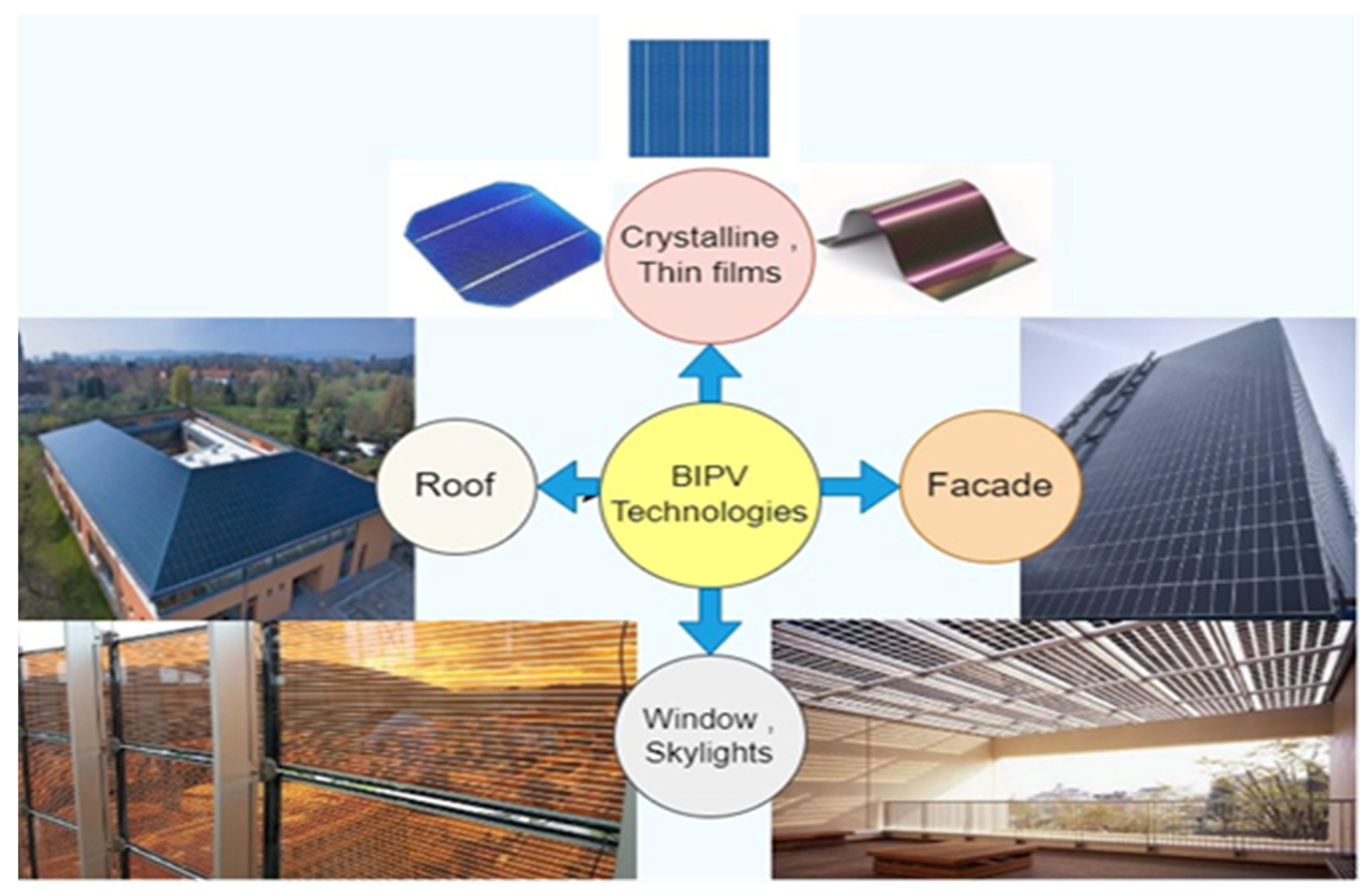
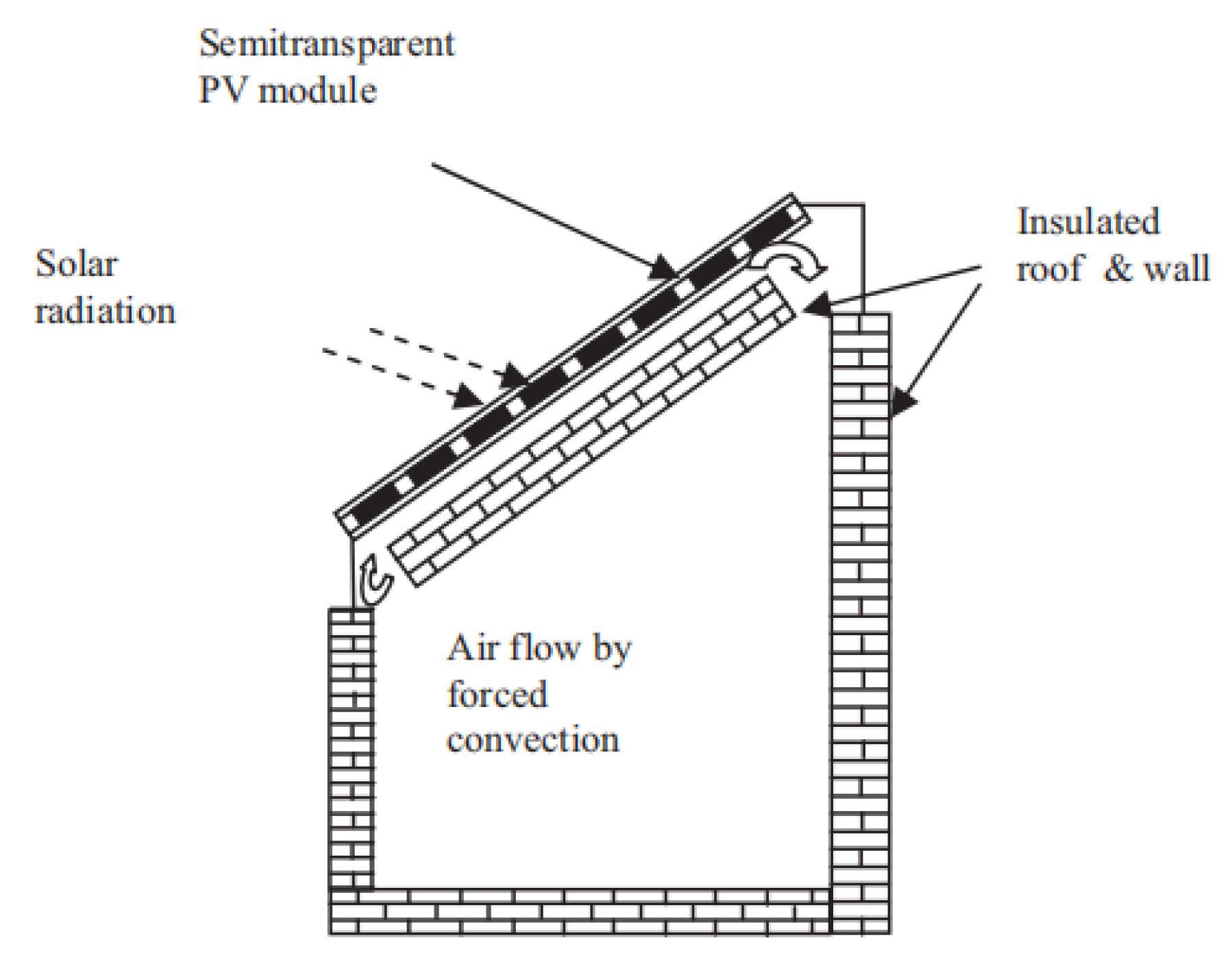


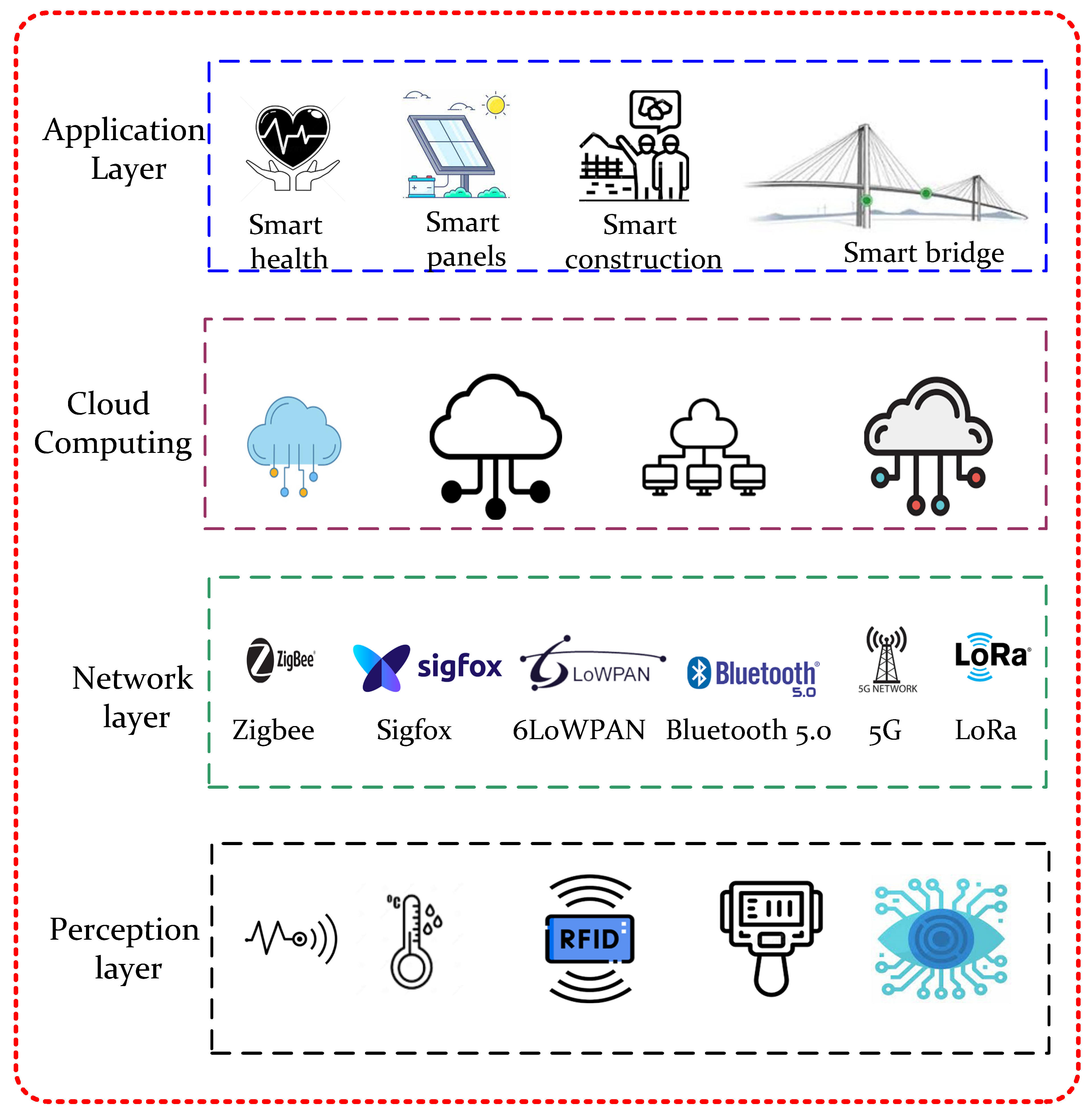


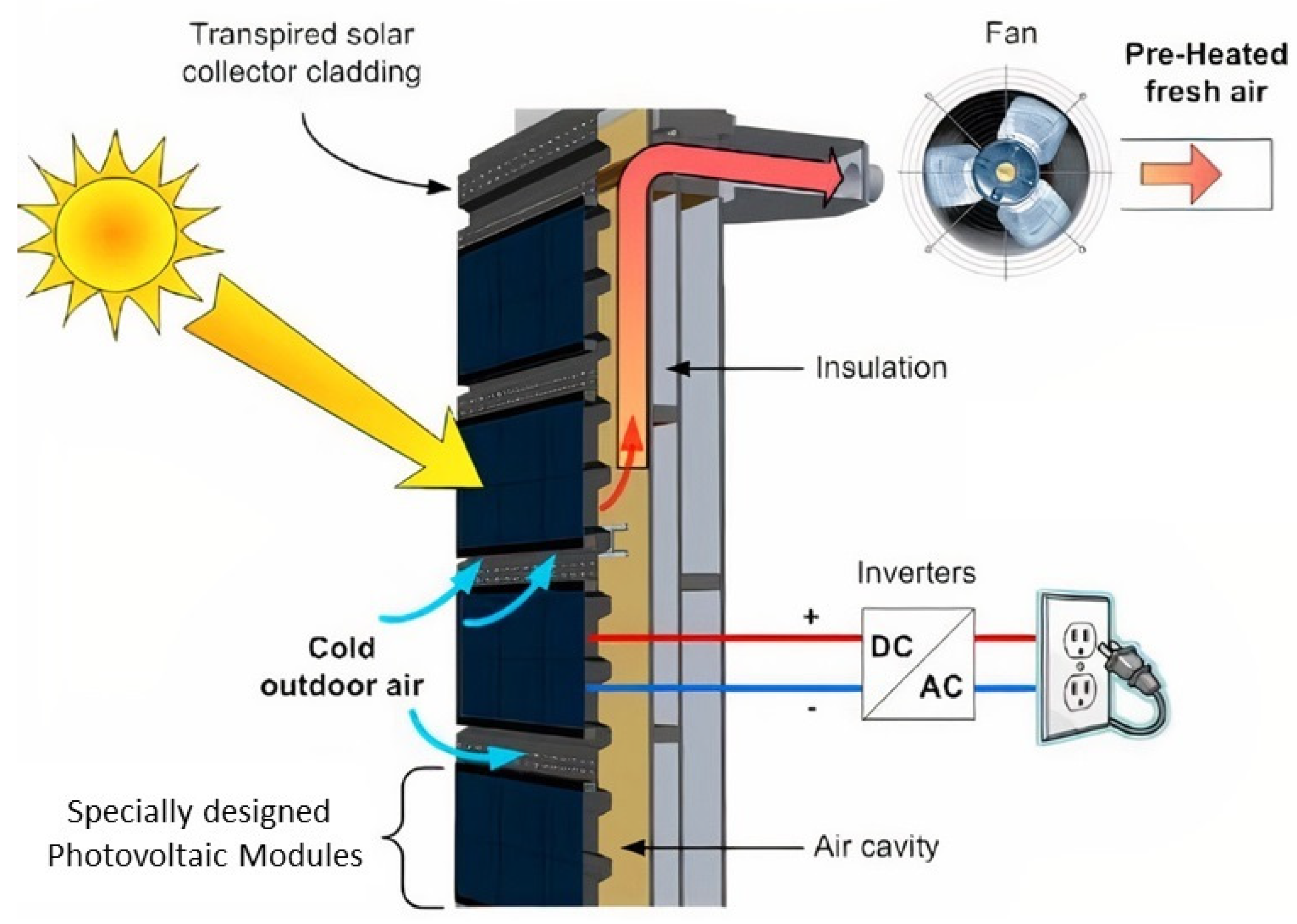

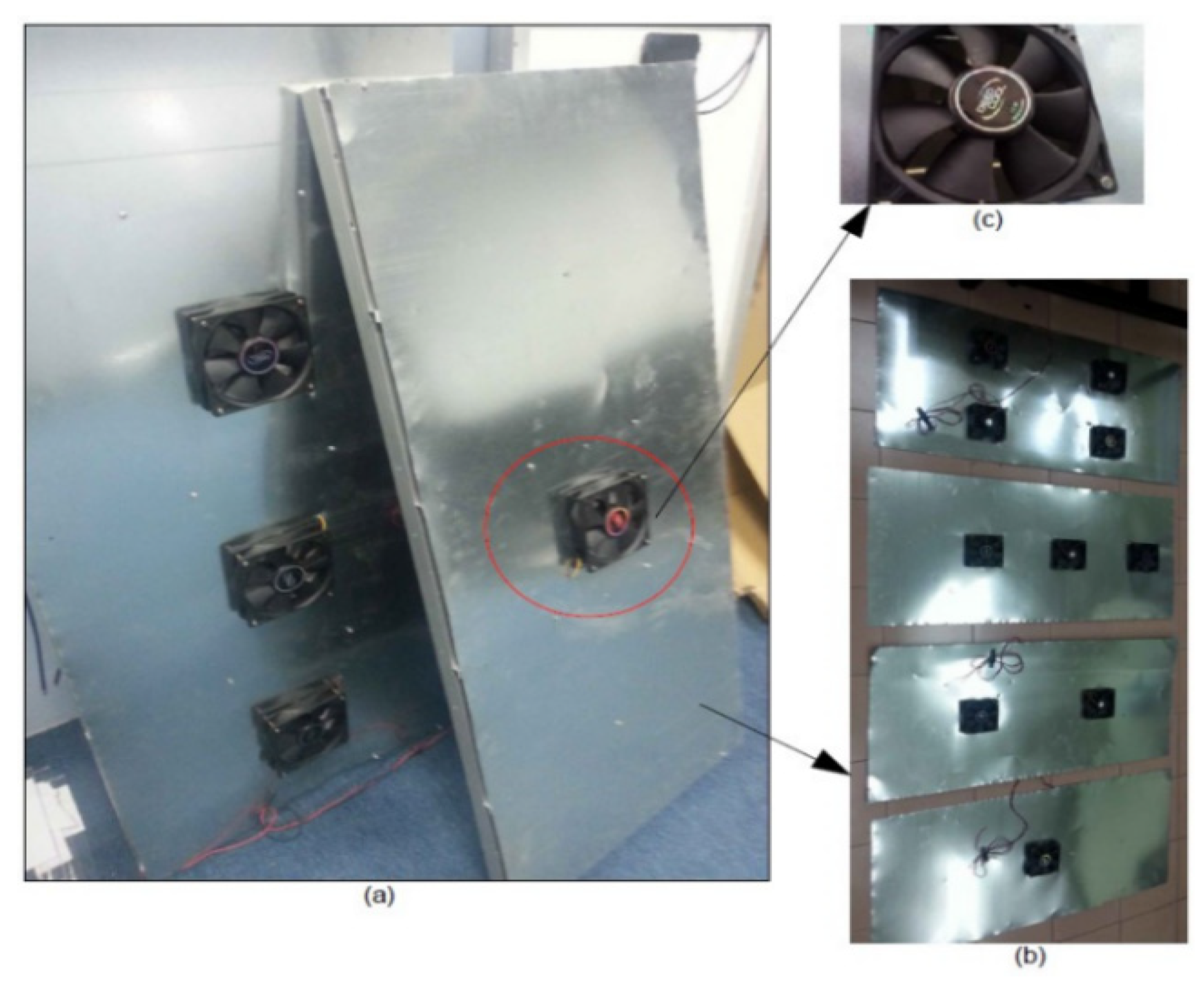
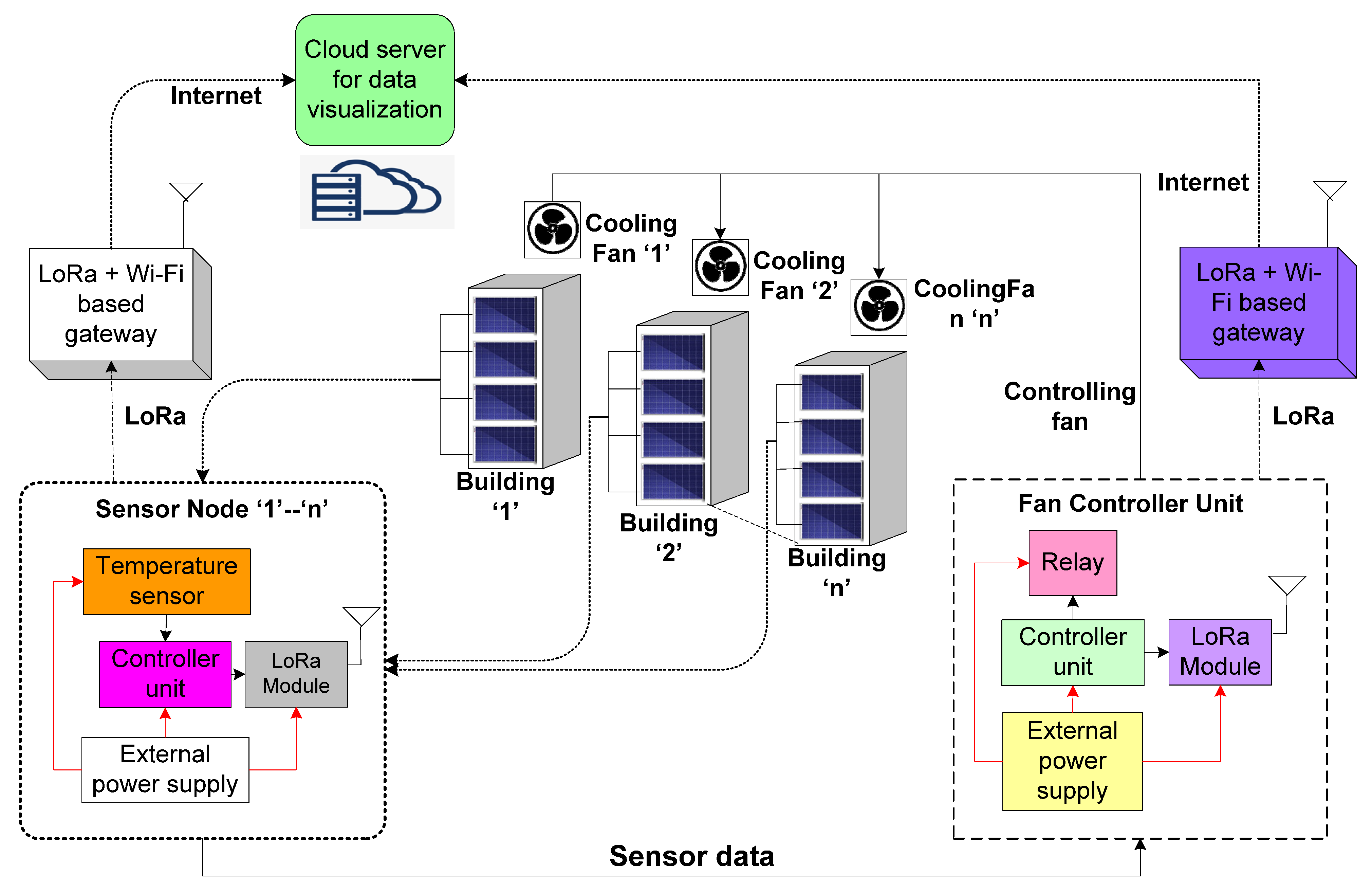

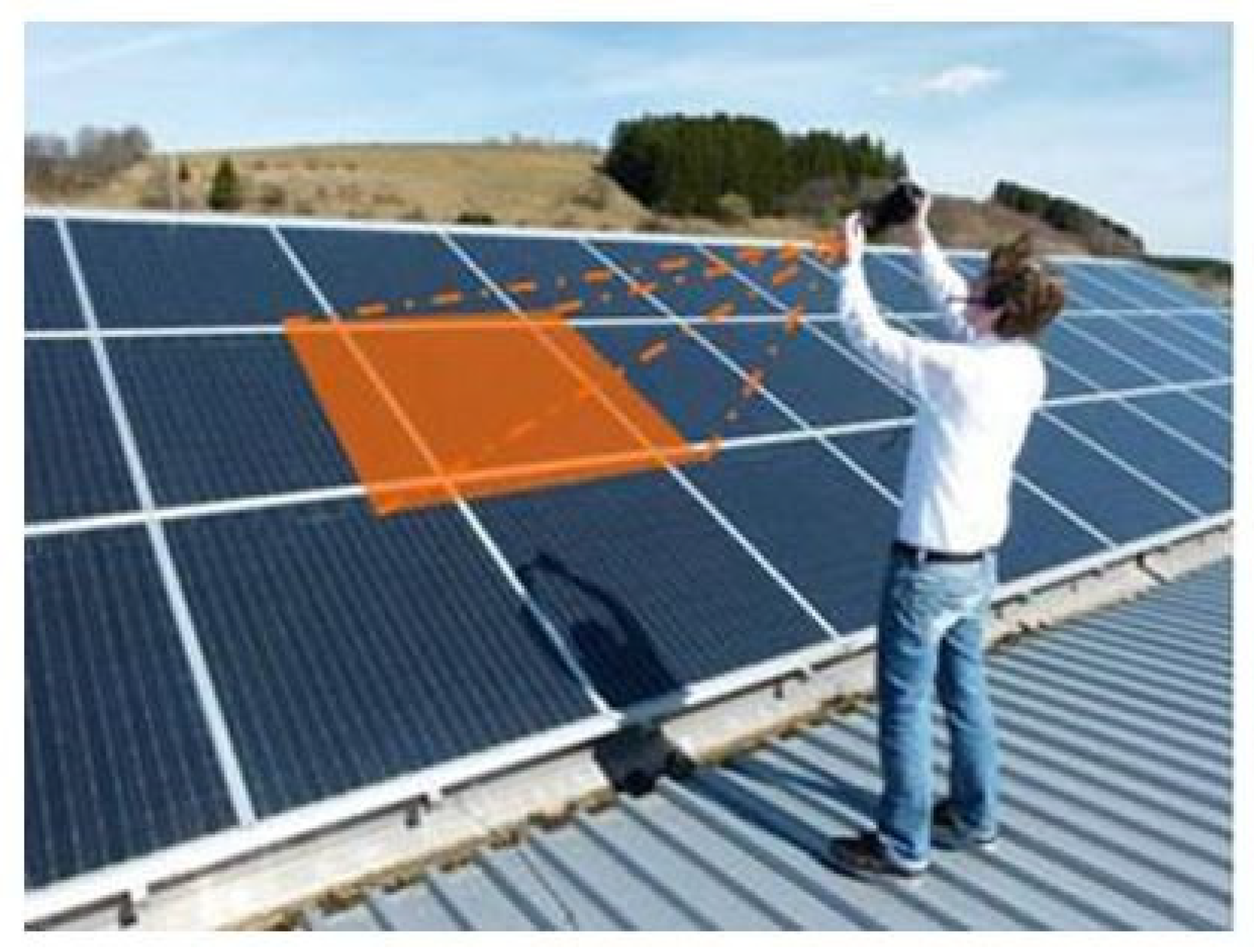
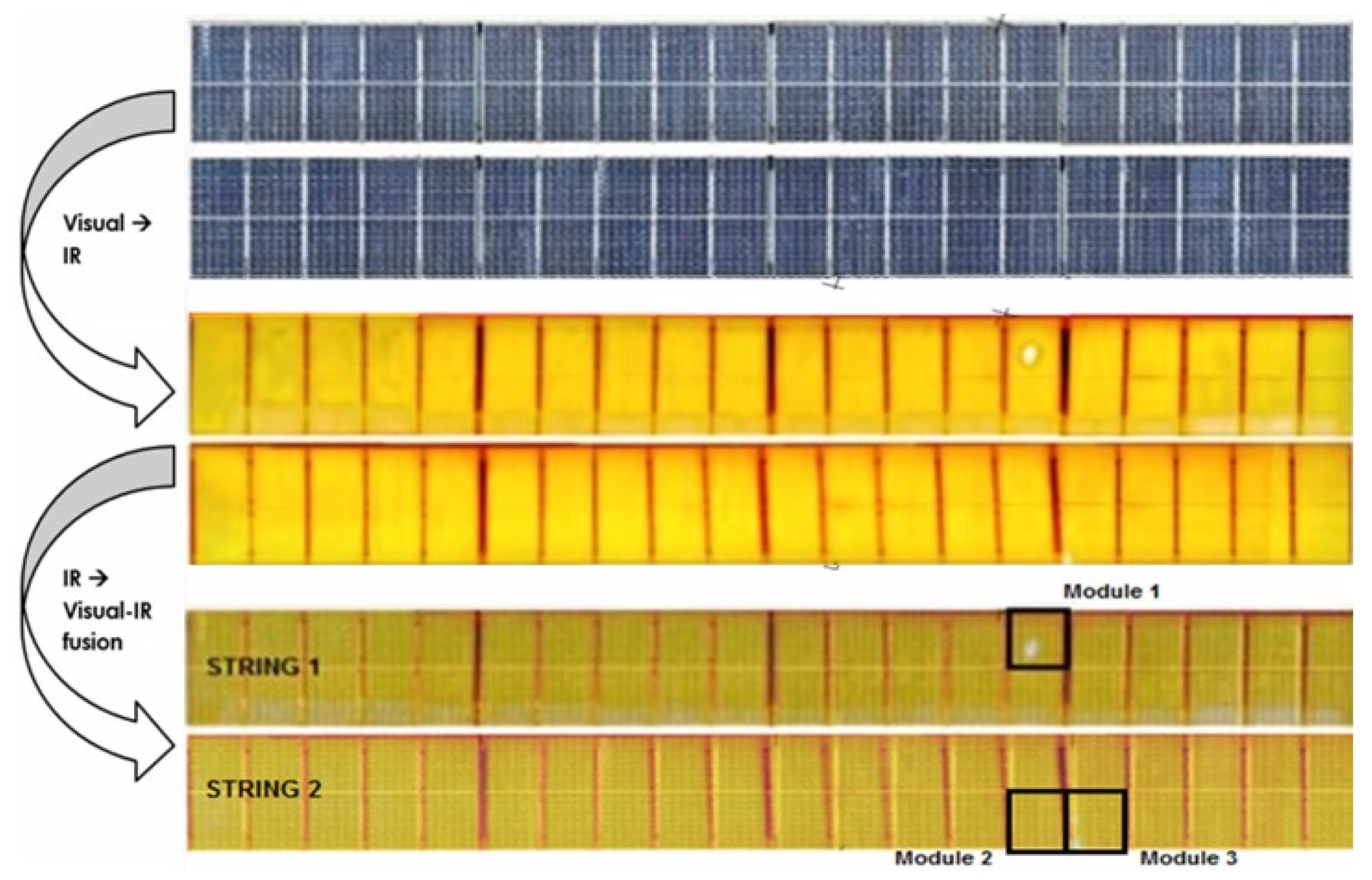
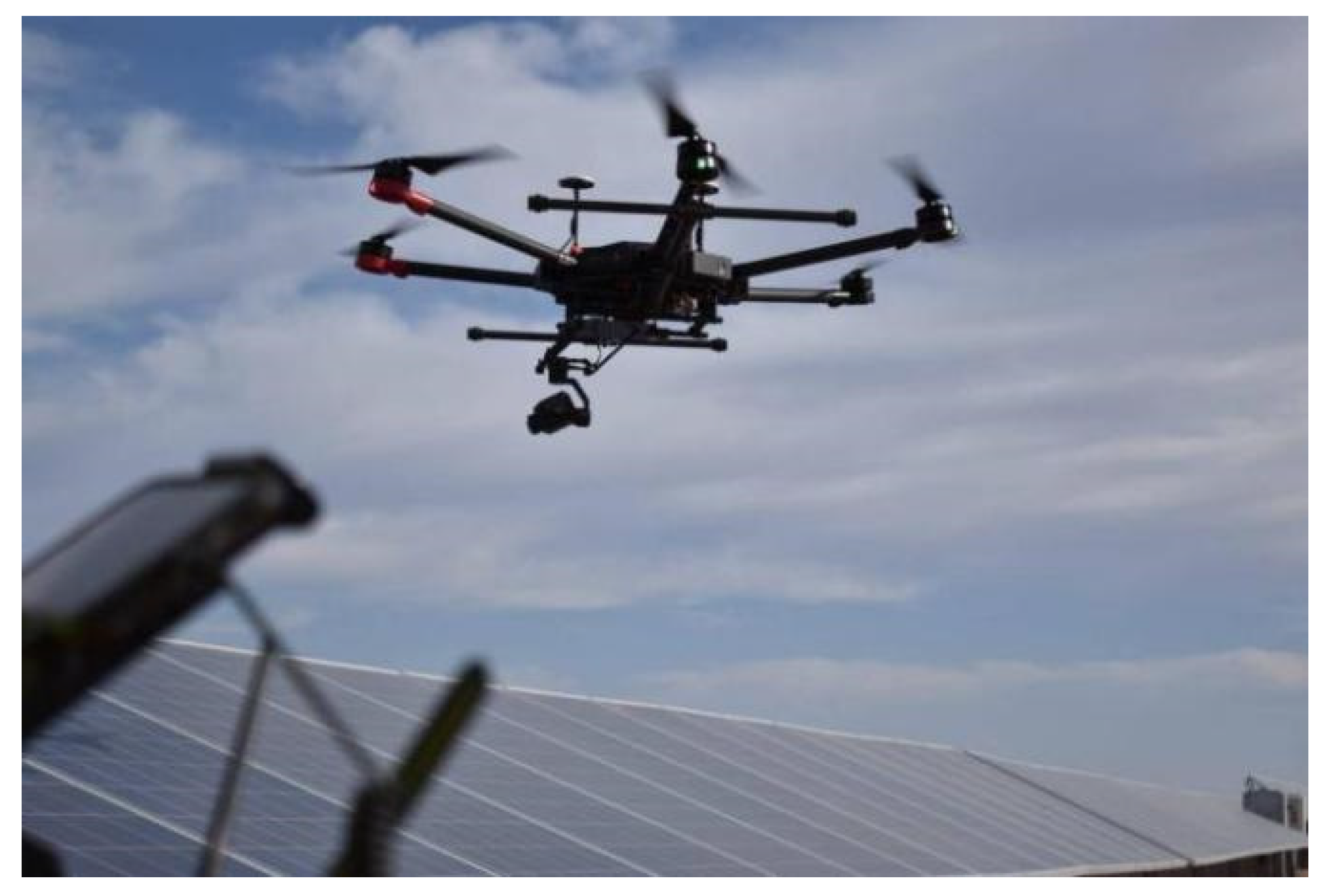
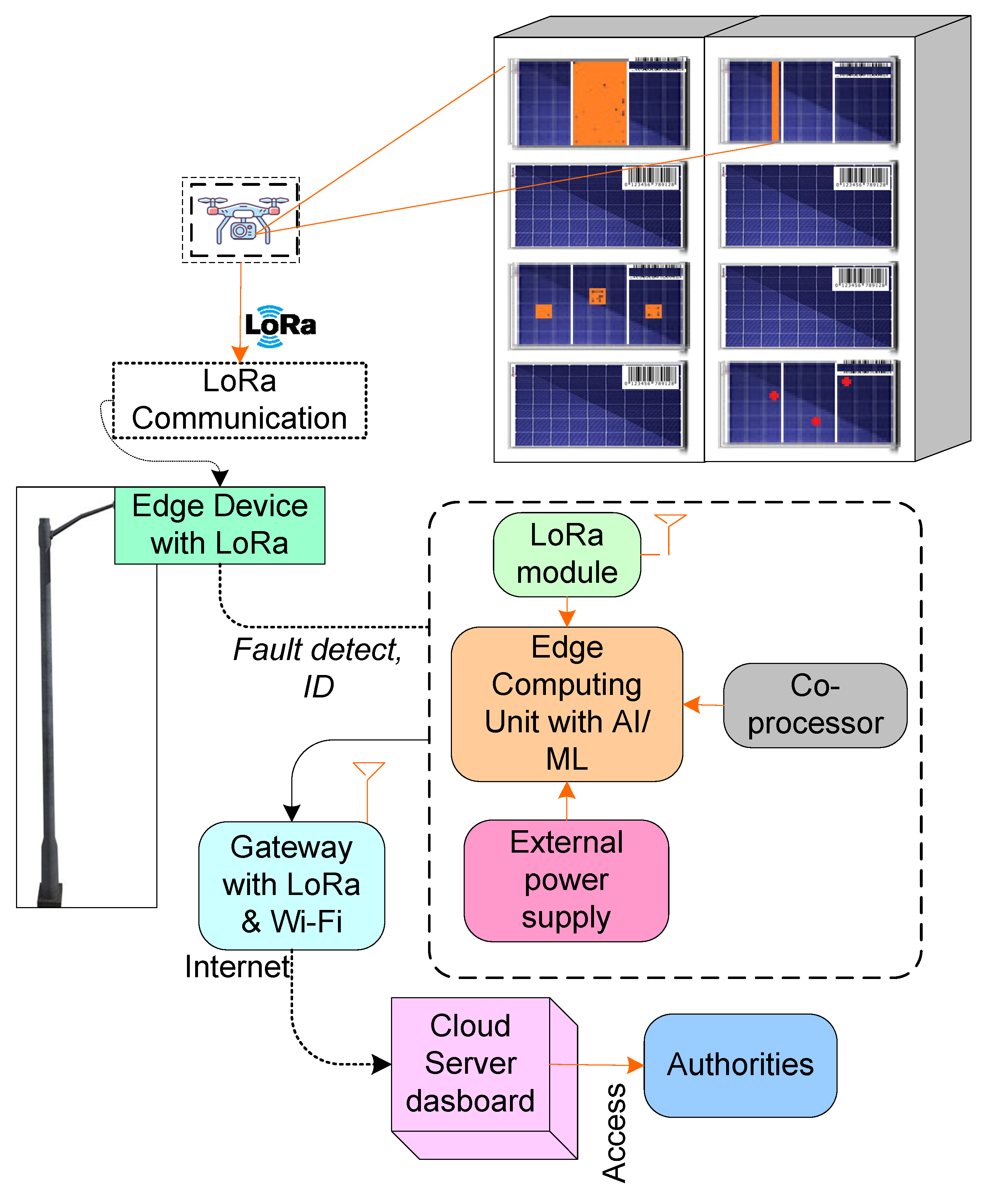
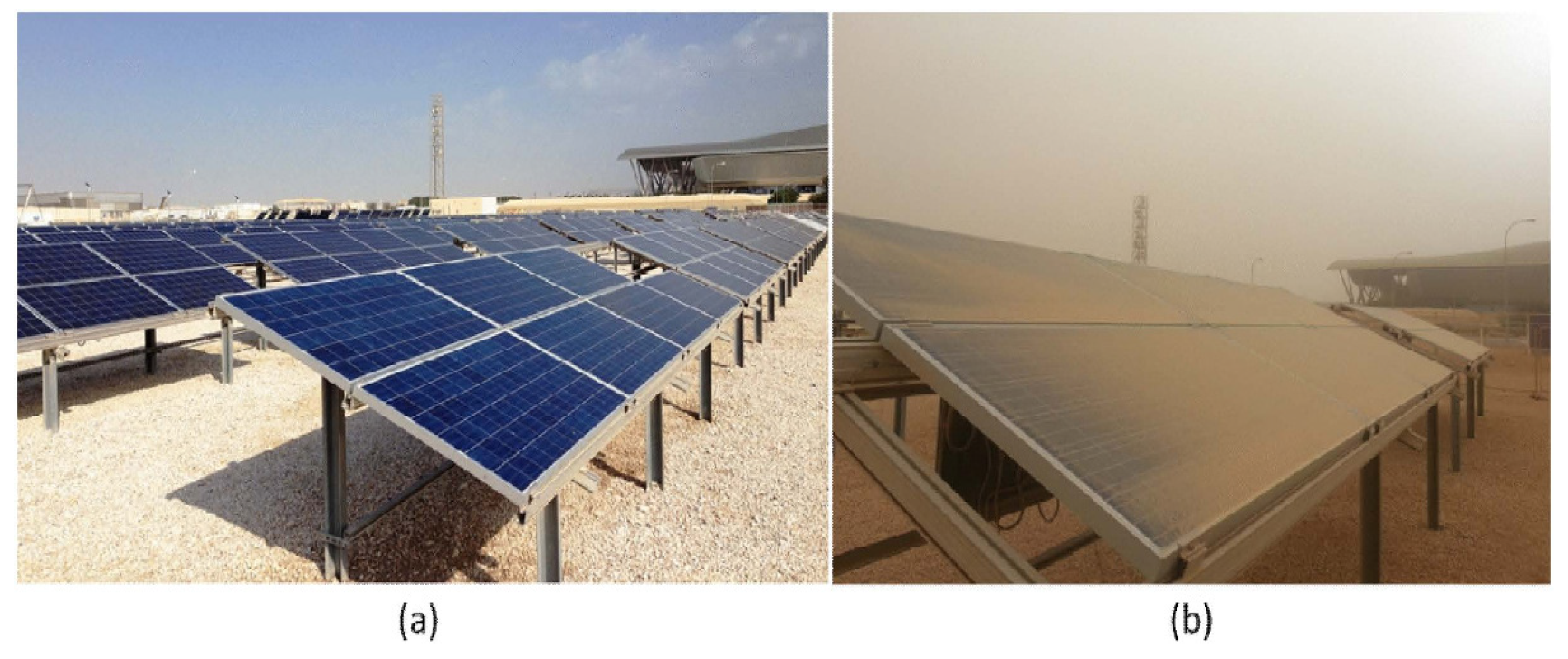
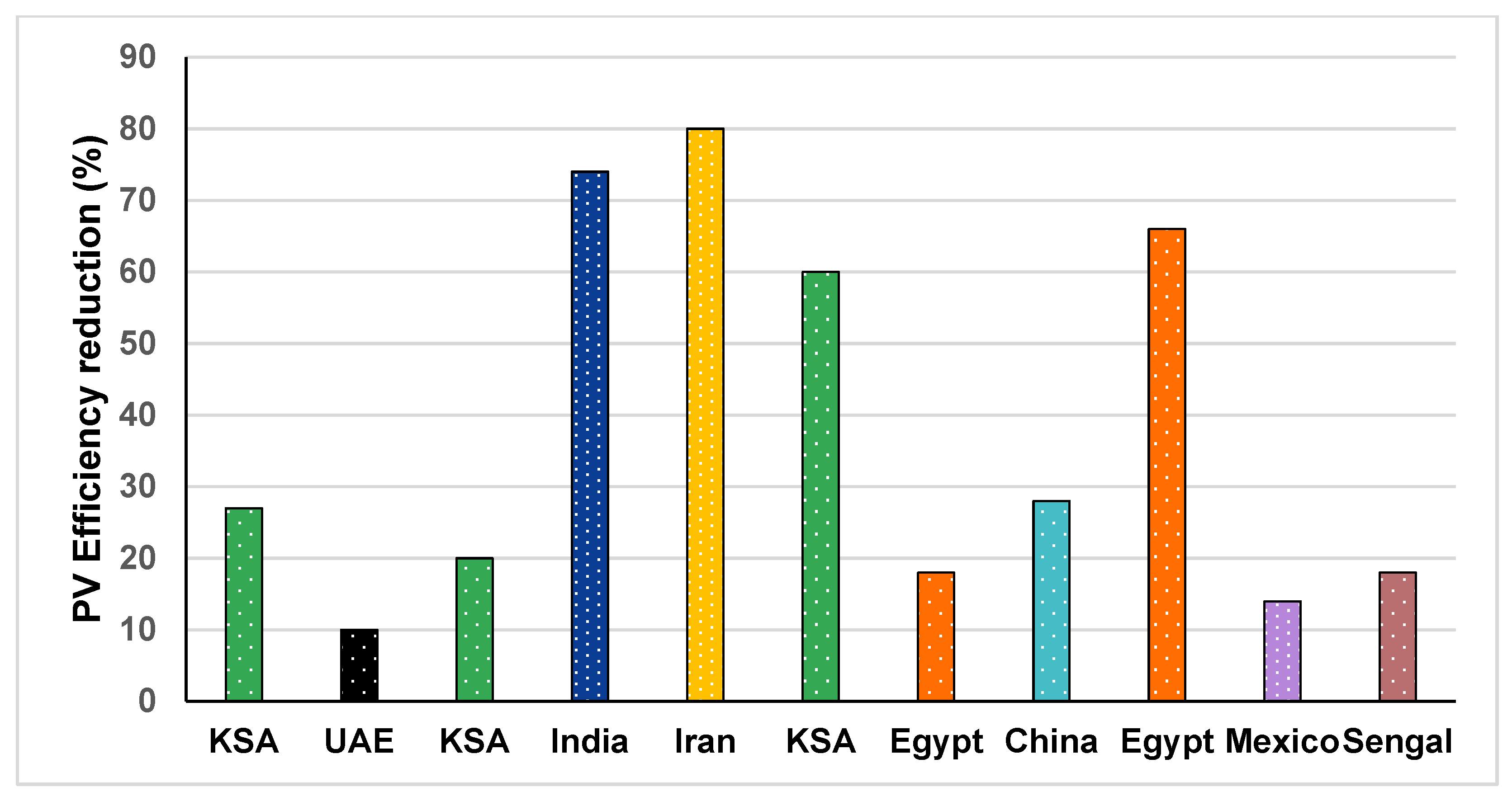
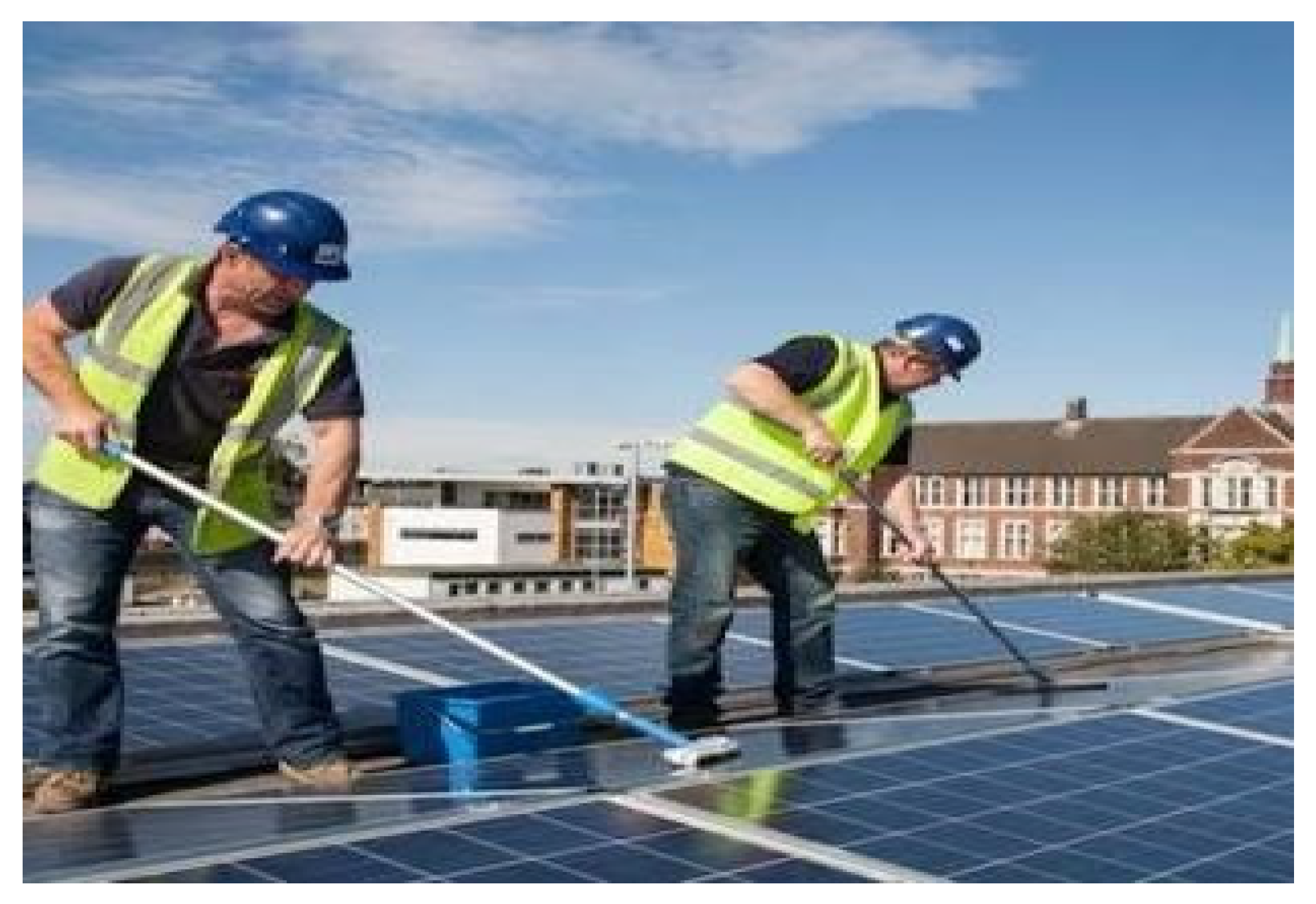
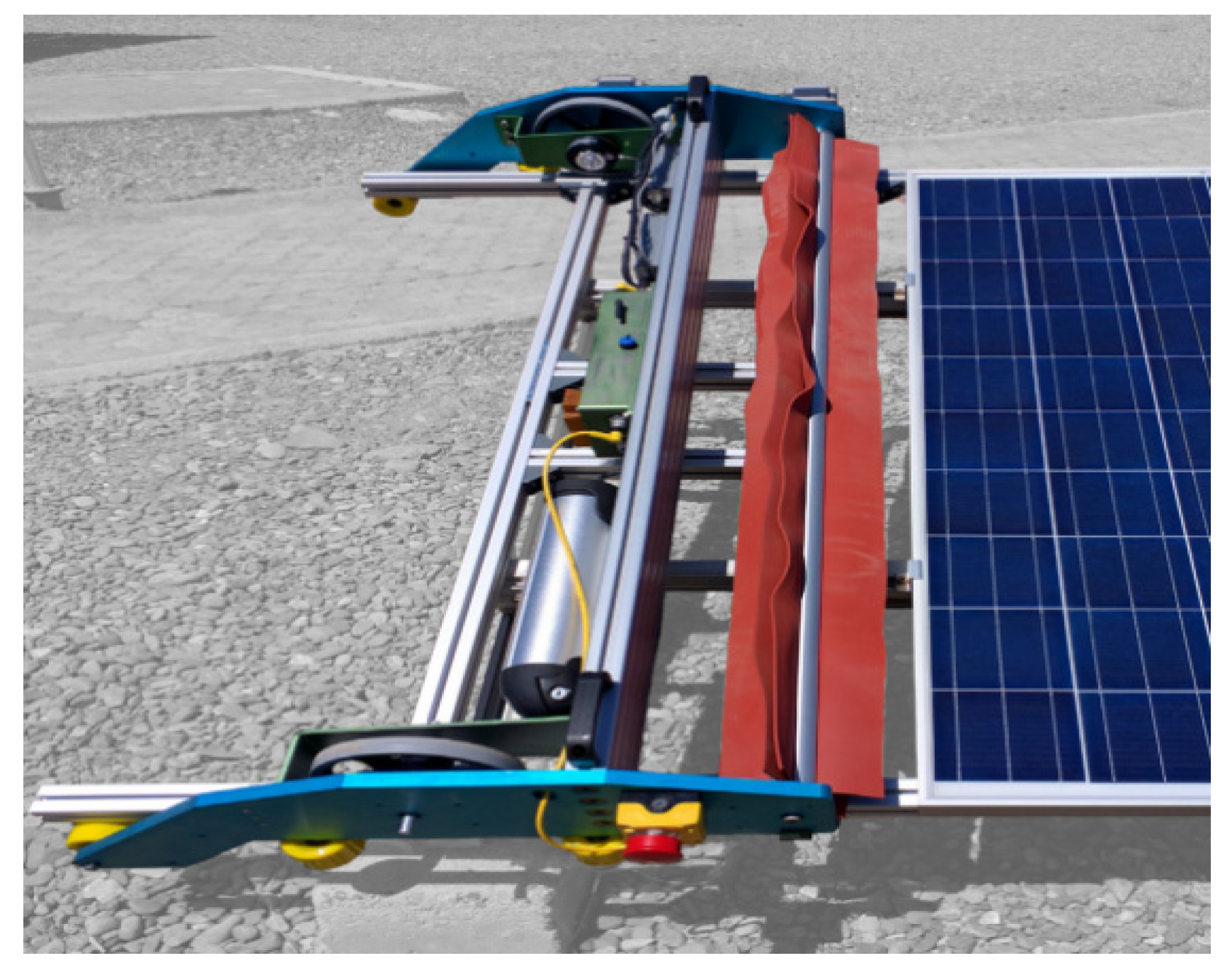

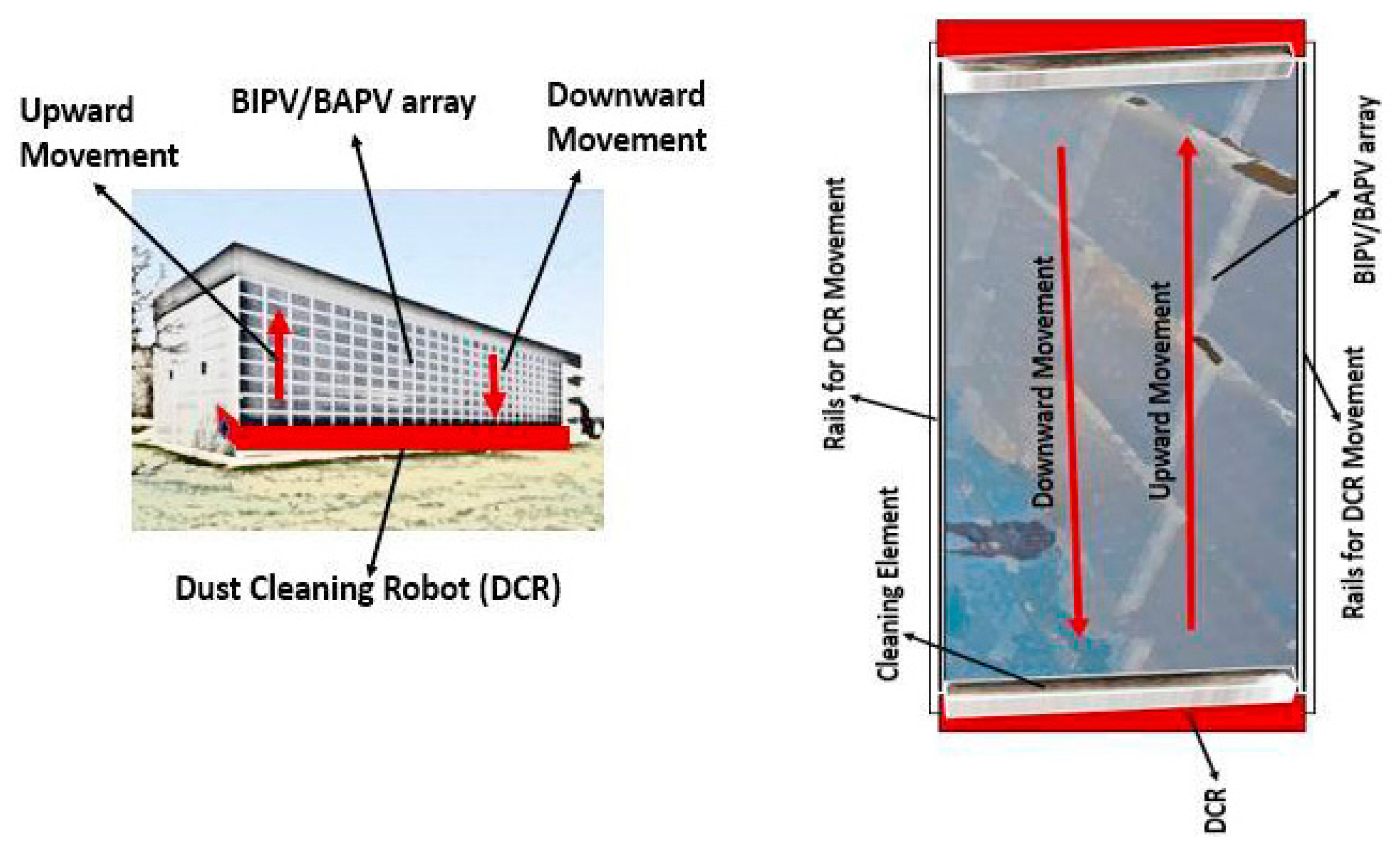
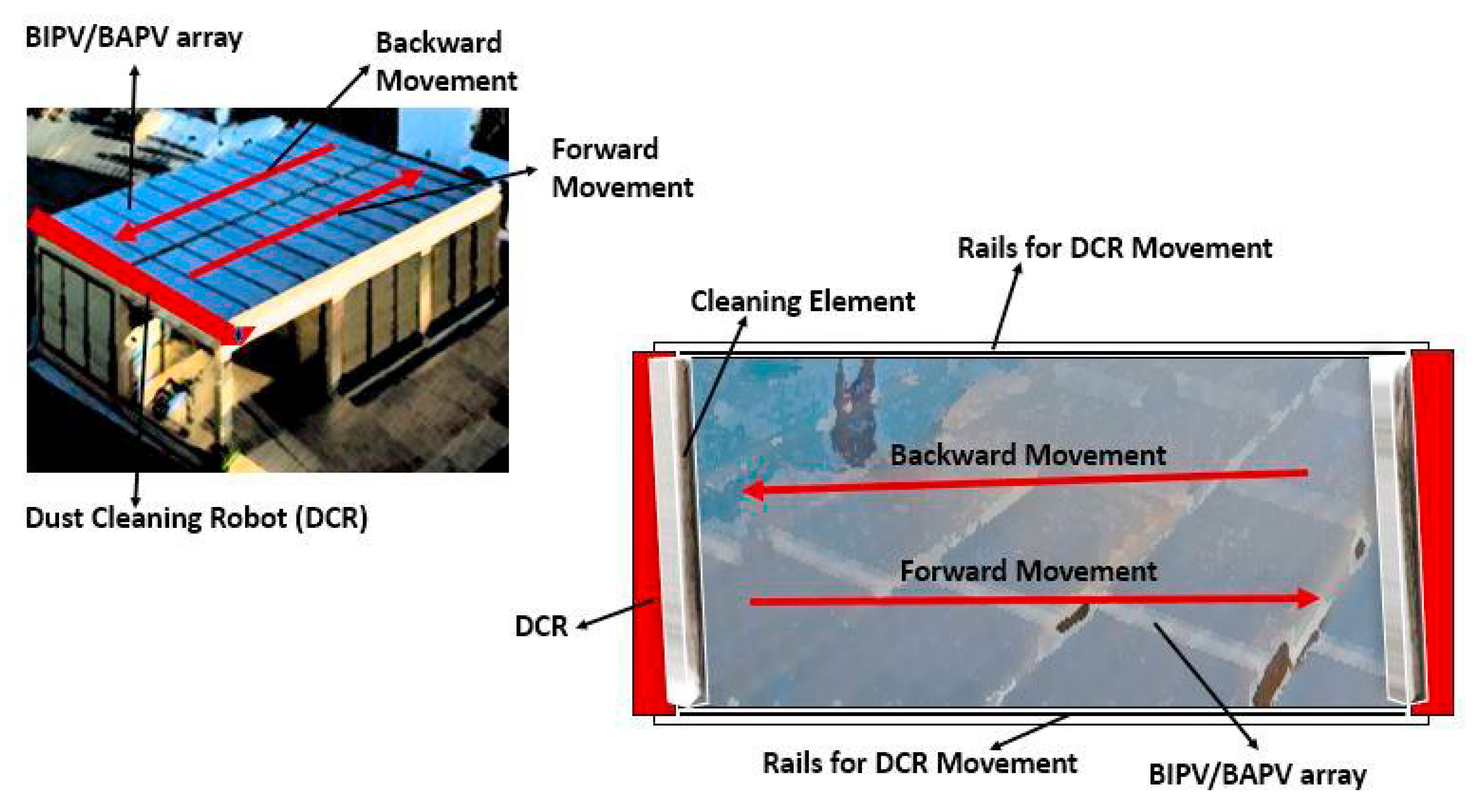

| Sensing Device | Function |
|---|---|
| Current | Detects and converts current to an easily measured output voltage, which is proportional to the current through the measured path. |
| Voltage | The input is the voltage and the output is its analog voltage signal, a current signal, or an audible signal. |
| Optical | Measures the physical quantity of light rays and converts this into electrical signals which can be easily read by the instruments. |
| Radiometric | Measures the UV irradiance or illuminance with the radiometer. In the case of non-vertical irradiation, the diffusers inside the sensors ensures the cosine correction. |
| IR | Emits or detects infrared radiation in its surroundings and also measures the heat emitted by the objects. |
| Lux meter | Converts the amount of light that falls on the photodiode into a current form. The amount of current measured will give the approximate value of lux radiation falling on the surface. |
| Pyranometer | Measures the potential difference developed due to the temperature difference between two surfaces of the thermopile. The gradient of temperature is used to measure the sum of solar radiation. |
| Anemometer | Measures the input power required to maintain the temperature of the hot wire cooled down due to the flow of air. The input power is utilized as the measurement of airspeed. |
| Temperature | Measures the temperature through an electrical signal using the thermocouple. The thermocouple will change electrical resistance indirectly proportionally to changes in the temperature. |
| Humidity | Measures the change in electrical permittivity of dielectric material and change in the resistivity value of this resistive material for predicting the change in humidity. |
| Ref. | Elements | Sensors | Monitoring | Outcome |
|---|---|---|---|---|
| [41] | IoT | Temperature, radiance, humidity, pressure, wind speed, etc. | Instant power and energy |
|
| [42] | IoT | Temperature sensor, voltage transducers, current transducers, | Instant power and energy |
|
| [43] | IoT | Current, voltage, irradiation, and temperature. | Solar radiation, instant power, and energy |
|
| [44] | IoT | Current sensor temperature and humidity sensor, optical dust sensor | Instant power level, and weather condition |
|
| [45] | Drones, IoT | Radiometric sensors, thermographic camera | Dust accumulation on PV modules |
|
| [46] | Drones, image processing | IR camera | Dust accumulation |
|
| [47] | Robotic cleaning | voltage and current sensor | Dust accumulation |
|
| [48] | Robotic cleaning | Illuminance sensor, voltage, and current sensor; temperature and humidity sensor, dust sensor. | Dust accumulation |
|
| [49] | IoT, Cloud | Temperature sensor, voltage transducers, current transducers, | Dust accumulation, open circuit, shading effect |
|
| [50] | Drones, IoT, image processing | voltage and current sensor; an optical and thermal camera | Instant power level, faults, weather condition |
|
Publisher’s Note: MDPI stays neutral with regard to jurisdictional claims in published maps and institutional affiliations. |
© 2022 by the authors. Licensee MDPI, Basel, Switzerland. This article is an open access article distributed under the terms and conditions of the Creative Commons Attribution (CC BY) license (https://creativecommons.org/licenses/by/4.0/).
Share and Cite
Singh, D.; Akram, S.V.; Singh, R.; Gehlot, A.; Buddhi, D.; Priyadarshi, N.; Sharma, G.; Bokoro, P.N. Building Integrated Photovoltaics 4.0: Digitization of the Photovoltaic Integration in Buildings for a Resilient Infra at Large Scale. Electronics 2022, 11, 2700. https://doi.org/10.3390/electronics11172700
Singh D, Akram SV, Singh R, Gehlot A, Buddhi D, Priyadarshi N, Sharma G, Bokoro PN. Building Integrated Photovoltaics 4.0: Digitization of the Photovoltaic Integration in Buildings for a Resilient Infra at Large Scale. Electronics. 2022; 11(17):2700. https://doi.org/10.3390/electronics11172700
Chicago/Turabian StyleSingh, Digvijay, Shaik Vaseem Akram, Rajesh Singh, Anita Gehlot, Dharam Buddhi, Neeraj Priyadarshi, Gulshan Sharma, and Pitshou N. Bokoro. 2022. "Building Integrated Photovoltaics 4.0: Digitization of the Photovoltaic Integration in Buildings for a Resilient Infra at Large Scale" Electronics 11, no. 17: 2700. https://doi.org/10.3390/electronics11172700
APA StyleSingh, D., Akram, S. V., Singh, R., Gehlot, A., Buddhi, D., Priyadarshi, N., Sharma, G., & Bokoro, P. N. (2022). Building Integrated Photovoltaics 4.0: Digitization of the Photovoltaic Integration in Buildings for a Resilient Infra at Large Scale. Electronics, 11(17), 2700. https://doi.org/10.3390/electronics11172700








